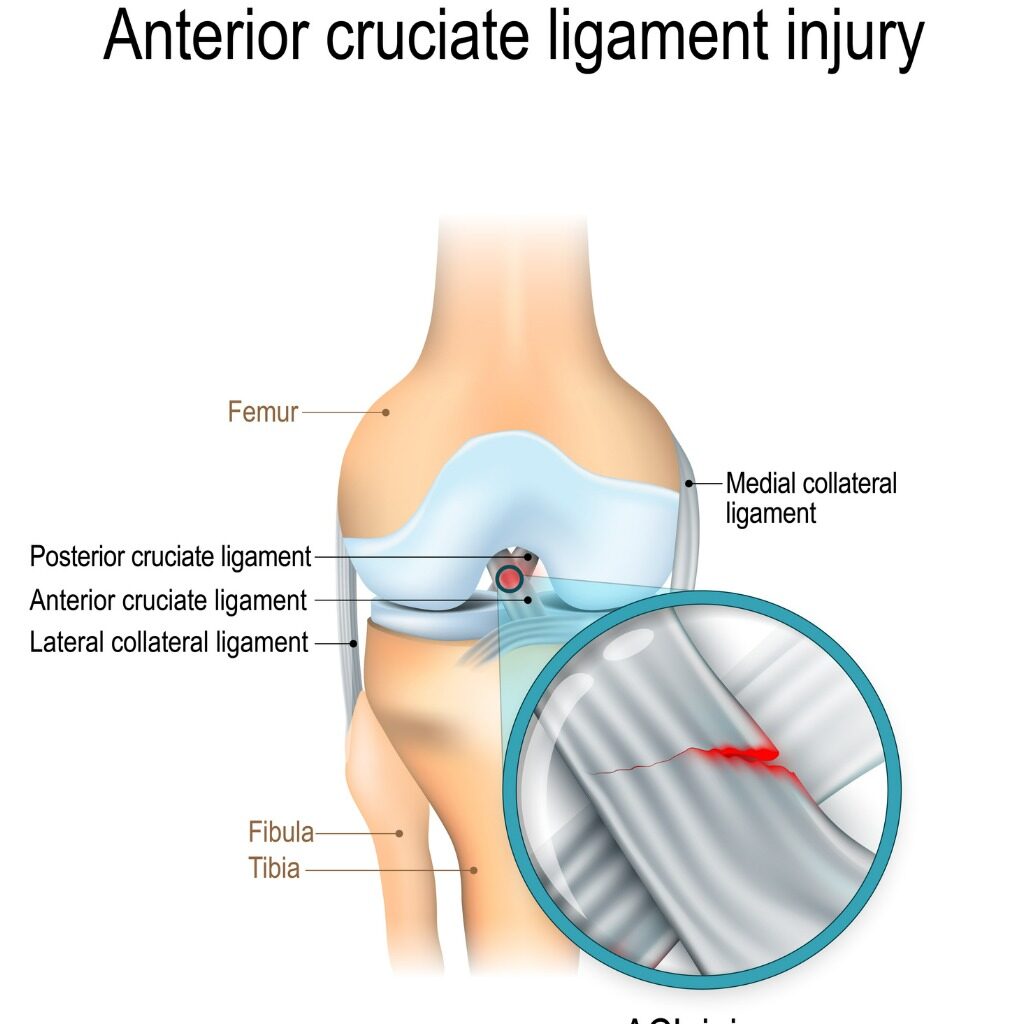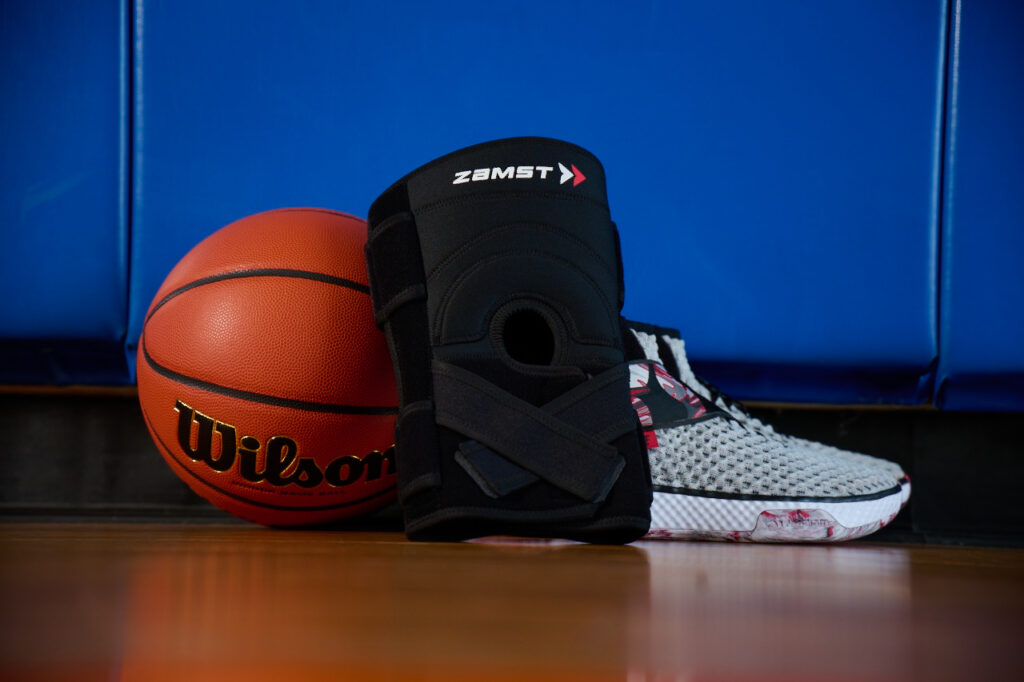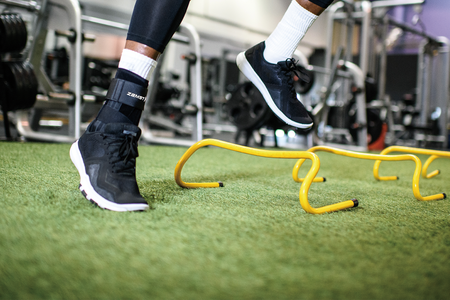Knee injuries in athletes are common because of the amount of force generated during movement. There are four ligaments that act like strong ropes by holding the knee together to keep it stable. One of the most important ligaments is none other than the anterior cruciate ligament (ACL). The job of the ACL is to provide max stability of the knee and prevent the tibia (shin bone) from sliding forward on the femur. It has become the most dreaded and common type of knee injury for athletes. ACL tears come with a long rehabilitation and recovery time to return to sports making it one of the hardest injuries to come back from.
What is the role of the ACL for the knee?
The ACL is one of two cruciate ligaments that stabilizes the knee joint by preventing excessive tibia translation forward and rotational knee movements.1 The ACL secondarily functions to restrain internal rotation especially when the knee is close to full knee extension.2 Unfortunately, it is one of the most common knee injuries in sports and it does not heal on its own when it is torn. Unlike the medial collateral ligament (MCL) that has great blood supply most of the time will heal on its own and not require surgery. The key to reducing ACL injuries is finding ways to reduce impact on the knee joint.

Signs and Symptoms of an ACL tear
There are three typical mechanisms of ACL injuries
- Direct contact
- Indirect contact
- Non-contact
Around 70% of ACL tears are a result of non-contact plays in sports.3 This is often associated with a sudden change in direction, speed change while foot is planted, rapid deceleration, jumping or pivoting. ACL injuries are classified into different grades of sprains
- Grade I: Ligament fibers are stretched but not torn, knee joint is stable and mild tenderness/swelling is present
- Grade II: This is a partial tear of the ligament fibers, the joint may feel unstable and have pain and swelling
- Grade III: The fibers have been completely torn and there is swelling, but limited pain because the pain fibers have been torn. There is instability and feeling of laxity with clinical provocation test
Who is at risk for ACL tears?
The biggest population that is affected by ACL injuries are people that participate in sports. Typically, those individuals that are between the ages of 14-19 are at highest risk. The incidence of ACL injuries is higher for the female athlete for the following reasons.3
- Smaller ACL and narrower intercondylar notch
- Wider pelvis and greater Q angle. The wider pelvis increases the angle of the femur toward the central part of the patella
- Ligament laxity: Female ligaments with more elastic fibers tend to be laxer than male ligaments
- Great quadriceps to hamstring strength ratio, females tend to have weaker hamstring strength to men and the hamstring acts as a secondary stabilizer of the ACL.
What type of movements lead to an ACL injury?
The predominant mechanism of ACL tears are non-contact activities including sudden directional or speed change while the foot remains planted, rapid deceleration, jumping, pivoting and direct impact to the anterior portion of the tibia. Something that tends to be observed with ACL injuries is the dynamic alignment of knee-in and toe-out creating a dynamic knee valgus force. Training athletes to improve hip and glute strength to reduce valgus force alignments in sports can possibly reduce the incidence of ACL tears.
Can you walk or run on an ACL tear?
One of the most unique characteristics of ACL tears are the fact that athletes often walk off on their own power after the injury. One thing we know about full Grade III tears is that the pain fibers are fully torn as well so once the initial shock of an injury happens often times they can walk off on their own power without much discomfort. Typically, ACL tears present with1
- A sensation of painful “pop” during the trauma
- Immediate swelling in the knee
- Painful or restricted range of motion
- Medial meniscus tears can be often associated with ACL tears
- A feeling of instability or that the knee gives away while performing activities
Injuries are unfortunately a part of sports but in particular ACL injuries can be truly devastating because of their long rehab associated with it. Knee injuries such as ACL tears are quite common among the youth between the ages of 14-19. The incidence of ACL injury is higher among females compared to male counterparts. Elena Della Donne of the WNBA has been a strong component of the ZAMST ZK-7 knee brace which helps support her knee while playing to reduce ACL injuries. Whether you are trying to prevent ACL injuries or rehabbing from ACL surgery protecting the knee during sports competition is important. Zamst provides a unique blend of comfort and support to keep you playing the sport you love.

ABOUT THE AUTHOR
EVAN JEFFRIES is a physical therapist with a Doctorate in Physical Therapy (DPT) from the University of St. Augustine for Health Sciences. He is also the owner of Evolving Motion and has vast knowledge of the musculoskeletal system and has treated many orthopedic conditions by bringing a proactive approach to healthcare and lifestyle. Recently he has also been active on social media as an injury analyst mainly in related to injuries NBA players have sustained. Evan can be followed on his social media accounts.
1.Yoo H, Marappa-Ganeshan R. Anatomy, Bony Pelvis and Lower Limb, Knee Anterior Cruciate Ligament. 2022 Jan Treasure Island (FL): StatPearls Publishing.
2. Fleming BC, Renstrom PA, Beynnon BD, Engstrom B, Peura GD, Badger GJ, Johnson RJ. The effect of weightbearing and external loading on anterior cruciate ligament strain. J Biomech. 2001 Feb;34(2):163-70.
3. Renstrom P, Ljungqvist A, Arendt E, Beynnon B, Fukubayashi T, Garrett W, Georgoulis T, Hewett TE, Johnson R, Krosshaug T, Mandelbaum B, Micheli L, Myklebust G, Roos E, Roos H, Schamasch P, Shultz S, Werner S, Wojtys E, Engebretsen L. Non-contact ACL injuries in female athletes: an International Olympic Committee current concepts statement. Br J Sports Med. 2008 Jun;42(6):394-412.






